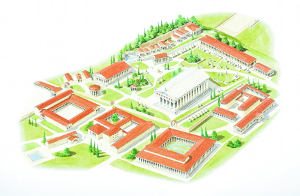Ancient Olympia
Olympia was a city-state in Ancient Greece most famous for two things: the Olympic Games and a Statue of Zeus that was considered one of the Seven Ancient Wonders of the World. 
Olympia was 10 miles from the Ionian Sea, at the junction of two rivers, near the western coast of the Peloponnese. The settlers there had access to verdant farmland and abundant wood from surrounding forested hills. Settlement is thought to have been up to 2,000 years ago; what is thought to have been the first place of worship was the Kronion hill, dedicated to the Titan Kronos. Zeus, the Greeks' chief god, was the focal point for religious zeal in Olympia. He was the celebrant for the Olympic Games, which took place every four years, beginning in 776 B.C. Athletes would cease their farming, trading, even fighting in battles to come to Olympia to take part in athletic contests and other elements of the Festival of Zeus. Estimates are that as many as 40,000 people descended on Olympic every four years. Many of them brought with them tributes to Zeus in the form of money, weapons, and statues–all of which stayed behind when the visitors went home again. 
Olympia's Temple of Zeus was constructed in the mid-5th Century B.C. The temple was huge and filled for the most part with a 40-foot-high gold and ivory statue of Zeus, built by the famed sculptor Phidias. Another temple, built to honor Zeus's wife, Hera, was the first temple built in Olympia. The Temples of Hera and Zeus were within the Altis, or Sacred Grove of Zeus, a 600-foot-long open space bounded on one side by the Kronin hill that also included treasuries and other administrative buildings. The city-state also featured other large buildings, including a stadium, hippodrome, gymnasion, baths, and a swimming pool. Of particular interest during Olympic years was the Prytaneum, a building in the Altis that contained a perpetual fire and a banquet room for Olympic victors. Also taking place at Olympia were the Heraia Games for women, which preceded the Olympic Games and featured just one event, a foot race that was five-sixths the length of a stadion. Unlike the male competitors, the female runners wore clothes. The first Olympic Games featured just one event, the stadion run. Subsequent Games featured an expanded offering–at the most, 18 events were on offer– and the Games gained in participation and popularity. One of the Panhellenic Games, they continued to run every four years, including under Roman occupation, until A.D. 393, when the Roman Emperor Theodosius I banned them. The Temple of Zeus was a destination for a great many people until A.D. 426, when another Roman emperor, Theodosius II, called for its destruction as part of a ban on pagan festivals.
|
|
Social Studies for Kids
copyright 2002–2025
David White




